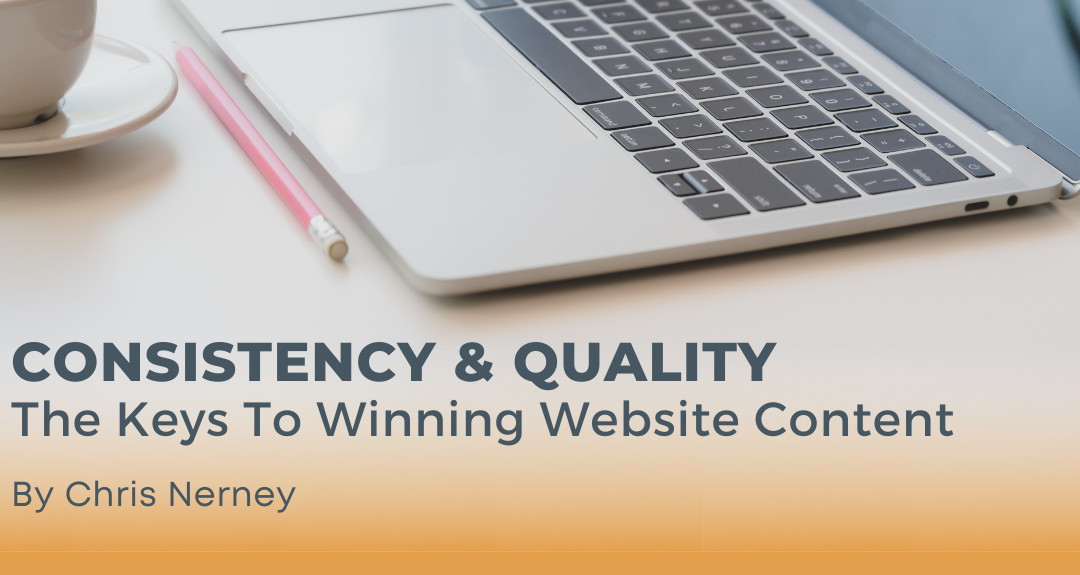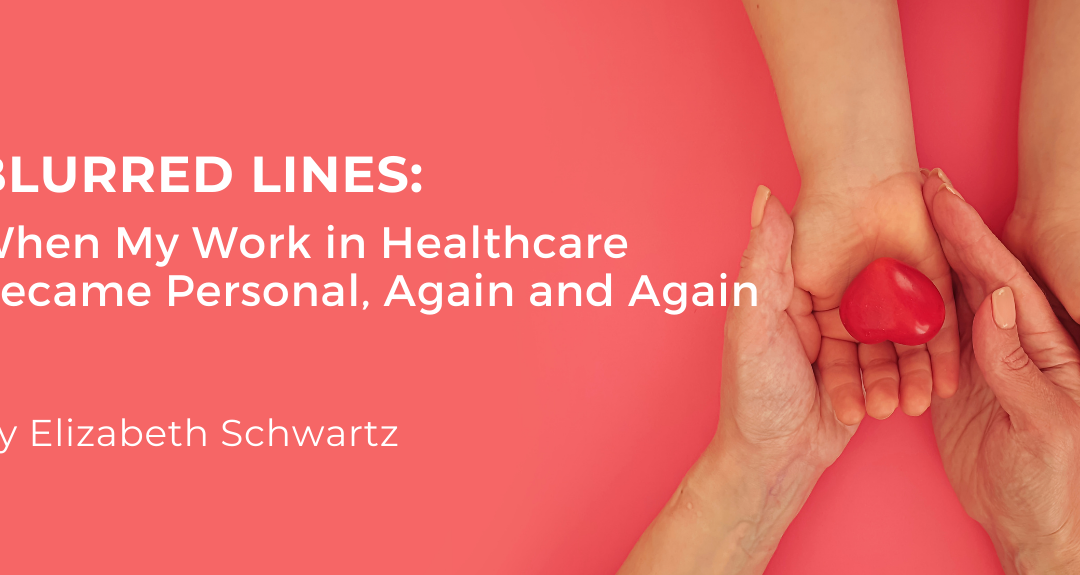
by Chris Nerney | Jan 19, 2022 | Blog
It takes a combination of hubris, masochism and bad judgment to write a blog post about the importance of writing quality blog posts. Reporting for duty.
Chicago web design and development company Orbit Media recently released its 8th annual blogging survey, and it is full of detailed data that should allow me to easily knock off this post fast enough to catch the opening kickoff on Thursday Night Football.
Just kidding! I am all about quality. And that’s because quality pays off. While this is confirmed by the survey, we all know intuitively that quality content has intrinsic value, whereas crap content does not. The challenge is in 1) defining what makes a quality blog post and 2) enacting a realistic strategy to produce some on a regular basis (very important!).
But we’ll get to that discussion later, about three paragraphs before I log off to go watch a little NFL action. First I want to go over blog trends highlighted by the Orbit Media survey of more than 1,000 bloggers, some of which are relatively predictable and some genuinely surprising.
It’s a big survey, so I can’t cover everything. But if you are responsible for making your healthcare organization’s content strategy a success, you’ll find some interesting trend data about SEO, traffic sources, analytics and headlines in the survey write-up by Orbit Media cofounder Andy Crestodina.
Bloggers spent 67% more time per post in 2021 than in 2014.
A typical blog post takes 4 hours and 1 minute to write in 2021, up from 2 hours and 24 minutes in 2014. Even I couldn’t ascribe this increase to improved procrastination techniques (though I’m a pro), so there’s got to be some other reason why blogs are taking longer to write. And there is…
Blog posts keep getting longer. The average is now 1,416 words.
Ebooks, anyone? I mean, seriously? Nearly one-third (32%) of blogs in 2021 are more than 1,500 words. Only 6% of blogs today are less than 500 words, versus 21% in 2014.
Which reminds me of when I attended a digital content conference in New York in 2007 or so. I vividly remember looking around the hotel ballroom and determining that there were maybe two people there who were older than me. (Full disclosure: I used an abacus in my first job.) Anyway, there was a guy in his early twenties on stage during a panel discussion who authoritatively proclaimed, “Anything over 300 words is an essay.” Combined with the demographics of the room, this purported truism made me feel rather ancient. Well, who’s the dinosaur now, Essay Boy?
This is not to conflate length with quality. Just look at this post: I’m 448 words in, have yet to say anything of substance, and there’s no end in sight! (Actually, there is an end in sight because it’s now 7:02.)
OK, enough fooling around. Time for some real value:
Bloggers who publish more frequently get better results.
Cadence matters. Nearly six in 10 (59%) of the bloggers surveyed who reported “strong results” from their work published at least weekly. This is something I’ve said before: You’ve got to publish regularly. That’s how you build an audience and raise your profile as a thought leader. To have a presence, you must be present.
What kinds of content are bloggers publishing?
“How to” articles are far and away the most popular form of blog content at 76%, followed by lists at 54%. Yet only 23% of bloggers reported “strong results” from “how to” blogs.
The biggest challenges for bloggers
Just what you’d expect: Finding time to create and promote content (53%), getting traffic and attracting visitors (49%), creating quality content consistently (39%), and creating enough content consistently (35%). All formidable challenges for which there are solutions!
Stirring, informative conclusion
Let’s focus on those challenges because the keys to quality content lie within them. To find time to create and promote content, Orbit Media suggests 1) delegate, hire and outsource, and 2) make content development a top-three priority for one team member.
Both excellent suggestions. Whether it’s someone in-house, an agency such as Amendola, or a freelancer with experience in healthcare, you need someone who can focus on the job and do it well.
As for driving traffic and attracting visitors, the first step is to ensure you’re producing quality content. One way to do that is to post blogs that include original information and research or a unique take on a high-profile problem for your target audience. Thought leaders lead, they don’t offer “me too” content.
Another way to improve your blog content is to incorporate outside voices of authority. Get a quote from a healthcare professional who’s not one of your clients. It will add credibility. Also, it always helps to have better ideas – and lots of them. Orbit Media suggests you “improve your process for capturing ideas, collecting examples and quickly starting articles.” Amendola, for example, works very closely with clients to regularly generate ideas and get the ball rolling on content production. An editorial calendar never hurts, either.
Finally, creating enough content consistently requires ownership and commitment. You’re in on a winning content strategy or you’re merely paying lip service. Being a lip-service payer is the road to mediocre results! While you shouldn’t do more than you can do without sacrificing quality, you can’t disappear for long stretches. Orbit suggests publishing a minimum of one or two blog posts a month, which sounds about right. That’s minimum!
Blogging can be an effective component of a healthcare organization’s communications strategy that makes you stand apart from your competitors. But you must be dedicated, consistent and committed to quality. That means devoting the time, money and talent necessary to do it well and support your organization’s messages and goals.
It’s 8:17. I’m just sayin’.

by Chris Nerney | Jan 19, 2022 | Blog
It takes a combination of hubris, masochism and bad judgment to write a blog post about the importance of writing quality blog posts. Reporting for duty.
Chicago web design and development company Orbit Media recently released its 8th annual blogging survey, and it is full of detailed data that should allow me to easily knock off this post fast enough to catch the opening kickoff on Thursday Night Football.
Just kidding! I am all about quality. And that’s because quality pays off. While this is confirmed by the survey, we all know intuitively that quality content has intrinsic value, whereas crap content does not. The challenge is in 1) defining what makes a quality blog post and 2) enacting a realistic strategy to produce some on a regular basis (very important!).
But we’ll get to that discussion later, about three paragraphs before I log off to go watch a little NFL action. First I want to go over blog trends highlighted by the Orbit Media survey of more than 1,000 bloggers, some of which are relatively predictable and some genuinely surprising.
It’s a big survey, so I can’t cover everything. But if you are responsible for making your healthcare organization’s content strategy a success, you’ll find some interesting trend data about SEO, traffic sources, analytics and headlines in the survey write-up by Orbit Media cofounder Andy Crestodina.
Bloggers spent 67% more time per post in 2021 than in 2014.
A typical blog post takes 4 hours and 1 minute to write in 2021, up from 2 hours and 24 minutes in 2014. Even I couldn’t ascribe this increase to improved procrastination techniques (though I’m a pro), so there’s got to be some other reason why blogs are taking longer to write. And there is…
Blog posts keep getting longer. The average is now 1,416 words.
Ebooks, anyone? I mean, seriously? Nearly one-third (32%) of blogs in 2021 are more than 1,500 words. Only 6% of blogs today are less than 500 words, versus 21% in 2014.
Which reminds me of when I attended a digital content conference in New York in 2007 or so. I vividly remember looking around the hotel ballroom and determining that there were maybe two people there who were older than me. (Full disclosure: I used an abacus in my first job.) Anyway, there was a guy in his early twenties on stage during a panel discussion who authoritatively proclaimed, “Anything over 300 words is an essay.” Combined with the demographics of the room, this purported truism made me feel rather ancient. Well, who’s the dinosaur now, Essay Boy?
This is not to conflate length with quality. Just look at this post: I’m 448 words in, have yet to say anything of substance, and there’s no end in sight! (Actually, there is an end in sight because it’s now 7:02.)
OK, enough fooling around. Time for some real value:
Bloggers who publish more frequently get better results.
Cadence matters. Nearly six in 10 (59%) of the bloggers surveyed who reported “strong results” from their work published at least weekly. This is something I’ve said before: You’ve got to publish regularly. That’s how you build an audience and raise your profile as a thought leader. To have a presence, you must be present.
What kinds of content are bloggers publishing?
“How to” articles are far and away the most popular form of blog content at 76%, followed by lists at 54%. Yet only 23% of bloggers reported “strong results” from “how to” blogs.
The biggest challenges for bloggers
Just what you’d expect: Finding time to create and promote content (53%), getting traffic and attracting visitors (49%), creating quality content consistently (39%), and creating enough content consistently (35%). All formidable challenges for which there are solutions!
Stirring, informative conclusion
Let’s focus on those challenges because the keys to quality content lie within them. To find time to create and promote content, Orbit Media suggests 1) delegate, hire and outsource, and 2) make content development a top-three priority for one team member.
Both excellent suggestions. Whether it’s someone in-house, an agency such as Amendola, or a freelancer with experience in healthcare, you need someone who can focus on the job and do it well.
As for driving traffic and attracting visitors, the first step is to ensure you’re producing quality content. One way to do that is to post blogs that include original information and research or a unique take on a high-profile problem for your target audience. Thought leaders lead, they don’t offer “me too” content.
Another way to improve your blog content is to incorporate outside voices of authority. Get a quote from a healthcare professional who’s not one of your clients. It will add credibility. Also, it always helps to have better ideas – and lots of them. Orbit Media suggests you “improve your process for capturing ideas, collecting examples and quickly starting articles.” Amendola, for example, works very closely with clients to regularly generate ideas and get the ball rolling on content production. An editorial calendar never hurts, either.
Finally, creating enough content consistently requires ownership and commitment. You’re in on a winning content strategy or you’re merely paying lip service. Being a lip-service payer is the road to mediocre results! While you shouldn’t do more than you can do without sacrificing quality, you can’t disappear for long stretches. Orbit suggests publishing a minimum of one or two blog posts a month, which sounds about right. That’s minimum!
Blogging can be an effective component of a healthcare organization’s communications strategy that makes you stand apart from your competitors. But you must be dedicated, consistent and committed to quality. That means devoting the time, money and talent necessary to do it well and support your organization’s messages and goals.
It’s 8:17. I’m just sayin’.

by Megan Moriarty | Jan 5, 2022 | Blog
One of the foundational PR rules that any communications professional learns is to avoid the use of jargon – the technical terminology or characteristic idiom of a special activity or group, as defined by Merriam-Webster. In my years working in PR for healthcare and health IT organizations, this has been a permanent item on my list of interview tips, and any media training I’ve conducted has included guidance to avoid the use of jargon.
When communicating to a general audience, this is sound guidance and standard practice. Jargon is unnecessarily complicated, can confuse your audience and cause your audience to lose interest. If your audience has tuned out because they don’t understand what you’re telling them, they won’t hear or read your message.
It may be tempting to include technical language to demonstrate proficiency and credibility with particular subject matter. This is an especially tricky trap for those of us who work in specialized areas like healthcare and health information technology. But there’s a fine line between using familiar terms and wading into the murky waters of jargon.
As with any marketing content, one size does not fit all. Public relations and marketing must be specific to your audience. Using technical language can demonstrate competency and help build credibility, if the audience can understand it. That’s why it’s crucial to do your homework, research your audience and their level of understanding.
Get to Know Your Audience
In a recent Amendola Communications blog post, my colleague Jack O’Brien reminded us that PR representatives should take time to do their research on the journalists and outlets that they’re pitching. Not only will this help you target your pitches to topics of interest, but it will also help you tailor your language to the journalist’s readers and the publication’s audience.
This is especially true for any media relations professionals who work in a specific industry, as we do at Amendola Communications. We work with a variety of reporters – from those who write for publications focused on a specific medial specialty, to trade reporters with a deep focus on health IT, to healthcare beat reporters at major national publications, to general assignment reporters at daily newspapers. The audience and level of understanding for each of these reporters and publications will be different, and so should each pitch. As you can see, one size definitely does not fit all.
Write in a Manner the Audience Will Understand
Once you’ve done your homework and you understand your audience, you should also delve into their level of familiarity and understanding of the topic you’re pitching. For example, if a publication targets physician executives, you can safely assume the audience will understand basic medical terminology because of their medical education. A physician discussing cardiovascular health can thus feel confident that the audience will understand the term “myocardial infarction.
However, if that same physician is instead speaking to the general public about heart health, it would be more appropriate to use the more colloquial and widely understood term “heart attack.” A good rule of thumb when pitching to and writing for a general audience is to avoid using language that your Aunt Sally wouldn’t understand.
Always Keep the Reader in Mind
I’ll offer some sage advice that one my college professors, Steve Kopcha, shared from his decades of experience in strategic communications: “Say it square, then say it with flair.”
It’s easy to get so caught up in figuring out how to “say it with flair” that we forget to first “say it square.” In the simplest terms that Aunt Sally would understand, how can you communicate what your client’s product or service does? What problem does it help to address? Why does this matter for the reader?
A former communications colleague of mine who had spent years as a local news reporter offered a helpful way to frame this concept. She would ask me how I’d explain something to my next-door neighbor, and why it would matter to them. When you find yourself struggling with whether to use technical language, ask yourself what it will mean to the person reading the article you’ve pitched. Will it help further their understanding, or does it muddle your message? Keeping the reader in mind will help you to walk that fine line between technical language that helps to inform and jargon that muddles your message.

by Jack O'Brien | Dec 22, 2021 | Blog
To be successful in business, you have to come up with a viable idea, develop it, bring it to market, and sell it to customers. That may be an oversimplified version of the formula but the basic principles are there: craft a product or service and then spend most of your time selling it far and wide.
As with so many things in healthcare, this process is more complicated than usual. Caring for patients is always the top priority but then there are also so many different stakeholders and revenue streams that muddle how a company should explore expansion.
Ultimately, healthcare executives are the guiding force that can bring an organization to the next level by embodying the mission statement, promoting value to the market, and winning over skeptics.
But in an era where the playing field is so flat, where new markets emerge only to experience a sudden rush of competitive saturation, companies have to stand out. The most obvious answer to an executive might be to rely on standard business strategies to address these challenges.
However, I would argue that the best way to differentiate yourself as a company and secure necessary industry credibility is to operate above the fray.Optics matter, so leaders must recognize that opportunities to interface with the media and stakeholders as a vendor-neutral voice of reason are an effective, proven way to better serve the business.
Casting yourself as an industry authority or subject matter expert pays dividends down the line because outsiders can look at you and realize you have more to say than simply reciting the same sales pitch over and over.
In the years I spent as a healthcare reporter, some of my most valuable contacts in the industry were accomplished executives that could speak to specific events or general trends in a vendor-neutral way.
Neither me nor my audience needed to know about how their RCM company was the best at streamlining the financial experience for patients or how their virtual care service was going to be the Holy Grail of care access. Quality journalists aren’t there to hand out superlatives or write puff pieces about executives and the companies that they run; rehashing a press release isn’t why reporters do what they do.
However, soliciting the opinions of healthcare’s movers and shakers never goes out of style. For example, if there’s a significant policy announcement affecting payers and I can get an insurance executive on the phone to talk about ramifications without reminding me that they were the first to offer certain benefits to members, then that’s a source I can reliably turn to again down the line.
Subtlety, rather than outright salesmanship, is the best way to position your organization for maximum opportunity.
Getting your name in print, on industry panels, or invited to deliver keynotes should always be the goal because then you build a natural rapport with the audiences you’re most seeking to connect with. Everybody wants what they say to have merit and thought leadership is the ideal exercise to make that happen.
Perhaps most importantly to note, you and your company don’t have to be the star of the story; you just have to be in the story.
Since the initial outbreak of COVID-19, healthcare innovation has enjoyed prime media coverage, the likes of which hadn’t been seen before. Whether it was telehealth, remote patient monitoring, or vaccine research, there were thousands of stories printed about fast-moving developments in an industry that has historically been averse to change.
In each of the stories that ran on television, in print media, or on podcasts, there were ample opportunities for leaders to chime in about the future of healthcare. Many participated, but I implore those who didn’t to reconsider their approach to promoting their brand.
If there’s an outlet or reporter asking to associate your name with a trending story or a noteworthy event, even one that likely will not give you the sole spotlight, you’re better off accepting that invitation because now you’re linked to it.
I know there’s a strong inclination to use any and every media appearance to preach the company’s gospel, but there’s an even stronger value in looking at the world from a 30,000-foot view. If you can step outside yourself and speak to topics that are not simply related to your company’s latest announcement, you will gain invaluable industry credibility and media contacts that will return to you without hesitation.
Thought leadership is not just a pie-in-the-sky buzzword for the most outgoing executives in healthcare, it’s a useful strategy to expand brand awareness that every leader and their communications teams should be pursuing if they haven’t done so already.

by Chris Nerney | Dec 8, 2021 | Blog
Smart healthcare companies invest in creating a quality digital presence, primary through their websites. I’ve launched my share of sites over the years and can tell you that a lot of planning, debate, creativity, and effort go into every facet of a company’s website, whether it’s brand new or overdue for a revamp.
Decisions must be made about everything that appears on a website – sections, design, images, and content. Writing content for a website is one of the most challenging jobs in content creation because you are under immense pressure to grab visitors immediately or risk losing them forever. A Chartbeat analysis of user behavior across 2 billion website visits showed that 55% of visitors stayed on a page for less than 15 seconds.
That’s why every word should contribute to telling a company’s story and positioning that company as unique in its market. I know from personal experience that creating website copy is a painstaking process of writing, rewriting, rewriting, hating your life, and rewriting. You can’t just dash off website copy! But the hard work invariably pays off for companies when their dazzling new website is launched.
While many startups are happy just to get their sites live – and it is an accomplishment – others have content plans that extend beyond the launch, such as a blog page. Which is shrewd because a steady stream of original content can demonstrate a company’s “thought leadership,” the ability of its executives to understand the business-critical issues and pain points facing its customer base. Further, blogs provide an opportunity for startups to establish a human connection (podcasts also are excellent for this) with potential customers, partners and investors.
Unfortunately, many startup blogs begin with a lot of energy and enthusiasm and then succumb to the harsh realities of continual content generation. Maybe the team member who championed the blog and did the bulk of the writing got another job. Maybe the CEO or CMO are too busy to contribute the monthly posts they promised. Stuff happens.
The problem is that a blog page containing only three or four posts, of which the most recent was from two years ago, doesn’t reflect well on your company. It looks like you don’t follow through or you ran out of ideas. Worse, you’re losing a chance to showcase the thought leadership that can separate you from your competitors in the minds of potential customers. Remember, many visitors to your site are actively searching for a solution. Your thought leadership content, in conjunction with the marketing content you perfected prior to the website launch, can be the differentiator that wins business for your company.
A blog page (or a section for videos or podcasts) won’t help your business at all, however, if it’s gathering cobwebs. I would argue that no thought leadership content is better than outdated content or a threadbare page.
Indeed, many healthcare startups make a conscious decision not to create a steady stream of content for their site, opting instead to focus their full efforts on the products and services they offer. That’s a valid decision if they truly lack the internal resources or budget to sustain a quality content creation program. And I suspect most visitors to a healthcare startup’s website probably don’t judge the company based on its lack of a blog. Conversely, a thinly populated and outdated blog/video/podcast section may leave a bad impression to website visitors, who likely won’t return.
Healthcare startups don’t have to publish fresh content every day or even every week to have a successful content strategy. Even a blog post a month can help you deliver your message and raise your profile if the content offers something of value for visitors. It can’t just be generic blather that checks off SEO boxes and gives you something to share on social media. Your content should position your company as a unique voice addressing serious, specific business challenges with effective solutions.
If your company lacks the bandwidth or skill set internally to produce content on a regular basis, freelancers can fill the gap, though the quality of content producers out there can vary wildly. That’s why working with an agency such as Amendola Communications is a sensible option. A marketing/communications agency specializing in healthcare can match the right writer to the right client, increasing the odds that the client’s content strategy pays off.
Website content isn’t easy and it isn’t free. But it can be incredibly valuable if it helps raise a company’s profile, which can attract customers, the media, and investors. Consistency and quality are the keys.

by Elizabeth Schwartz | Nov 24, 2021 | Blog
When I was a little girl, I always wanted to be a pediatrician. And a writer. I had no idea as an idealistic young lady that there wasn’t really a career that combined the two disciplines.
And when I learned how long I had to go to school to be a pediatrician, I leaned in a little more on the writing.
It wasn’t until I had leaned way into writing and four years of Journalism school that I got my first job at a multi-hospital research health system. I learned quickly that I could combine my three passions—helping people, healthcare and writing. I was not the one performing the lifesaving transplants, but through my writing I got to share the stories of two sisters who shared a lifesaving kidney transplant and encourage others to be organ donors. It was a great fit. I thought of it as writing. I had learned in Journalism school how to write a lead, a body and a close. I never thought of what I did as storytelling.
Then, as if it couldn’t get any better, I got a job as a writer at a pediatric hospital. I met awe-inspiring families struggling through unimaginable heartache but taking me along and allowing me into their lives to tell their story and show how they battled adversity with strength, bravery and grace.
I got to see the loving way nurses and doctors approached children and their families. I got to see the way parents looked bravely at their children and told them it was going to be OK even when they weren’t sure. I was humbled and grateful for each and every family. I remember thinking that I was so glad to be able to tell their stories but could never imagine being in their shoes. I had found my place: healthcare and writing. But then something happened that changed my perspective completely.
The Tide Turned
About two years into my job, I had children. My son and daughter are 18 months apart in age. When my daughter was six months old, she began to have seizures. We spent weeks in the hospital trying to find the root cause—from a brain tumor to epilepsy—what we found was that she had a stroke at birth and had cerebral palsy. When my son was two, he was diagnosed with autism. What had been unimaginable to me about the lives of those parents had become my life. We spent many days and nights with doctors, nurses, therapists—my colleagues—and now my child’s caregiver. I was the one of the parents that I had been writing about.
Why It Matters
My children have been a consistent source of joy and inspiration to me. I know that doesn’t make me unique as a parent, but when they were young, we journeyed through a lot together in ways I never thought I would experience. All the times I wrote those patient stories, I never knew one day it would be me.
I’m happy to report they are both thriving, active teenagers now. What I learned is that in some way for all of us, healthcare is personal. Whether it’s an aging parent, your own health challenges, or a child, when we walk through our healthcare system as a patient or a caregiver of a patient, it changes us.
For me, it changed the way I write. It changed the way I tell the story of the latest innovation in EHRs. It changed the way I appreciate the passion and selfless care that every single position in the healthcare ecosystem puts into what they do.
I think it’s easy as PR and Marketing professionals to get robotic and apathetic in the way that we amplify a brand or write a blog. What we should remember is that at the end of that journey is a real person with a real story. And you never know when that might be you. Write with your heart. Bring your own story in the passion you have for what you do. It will never steer you wrong.





